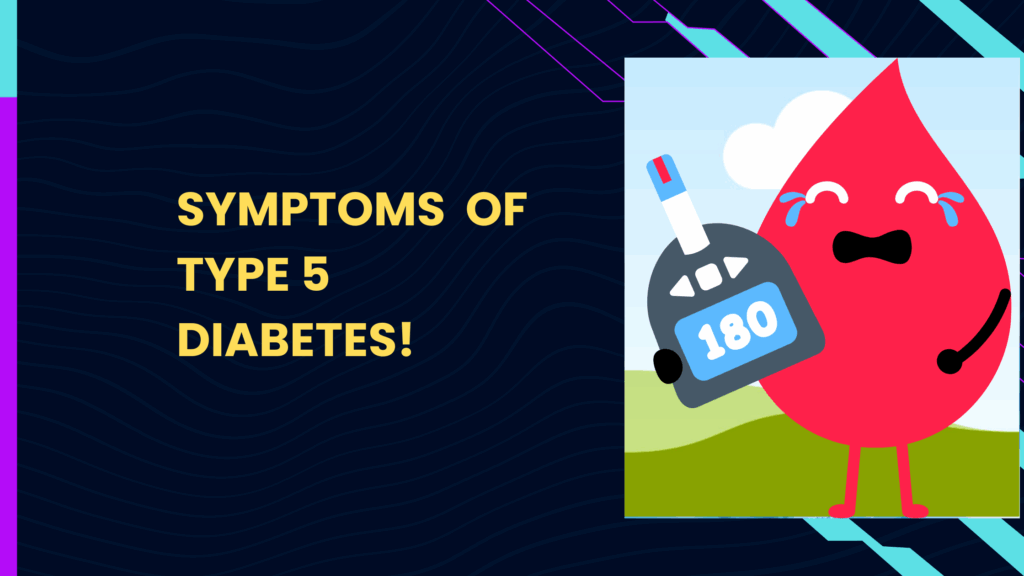Table of Contents
Introduction
Concerned about symptoms of type 5 diabetes in children? Learn about the key indicators of this malnutrition-linked condition and when to seek medical help.
As awareness grows about Type 5 Diabetes, also known as Malnutrition-Linked Diabetes Mellitus (MLDM), parents must understand its potential symptoms, particularly in the most susceptible children. Unlike Type 1 and Type 2 diabetes, symptoms of Type 5 diabetes often arise in the context of a history of significant undernutrition. Recognizing these signs early can lead to timely diagnosis and appropriate management.
It’s important to remember that the presentation of symptoms of type 5 diabetes can sometimes overlap with other conditions, making an accurate diagnosis by a healthcare professional essential. However, being aware of the key indicators can prompt parents to seek timely medical attention.
Key Symptoms of Type 5 Diabetes to Watch For:
While the classic diabetes symptoms of increased thirst (polydipsia), frequent urination (polyuria), and increased hunger (polyphagia) can be present in type 5 diabetes, they may be less pronounced or overshadowed by signs of malnutrition. Here are some crucial symptoms of type 5 diabetes to be vigilant about, especially in children with a history of undernourishment:
- Unexplained Weight Loss or Failure to Thrive: Despite adequate (or sometimes even increased) food intake, a child with type 5 diabetes might experience persistent weight loss or a lack of expected growth and development. This is a significant symptom of type 5 diabetes in the context of prior malnutrition.
- Fatigue and Weakness: Persistent tiredness and lack of energy are common symptoms of type 5 diabetes as the body struggles to utilize glucose effectively.
- Increased Susceptibility to Infections: Impaired immune function due to both malnutrition and diabetes can lead to frequent or severe infections, a notable symptom of type 5 diabetes.
- Abdominal Pain: Some individuals with type 5 diabetes, particularly those with fibrocalculous pancreatic diabetes (a subtype of MLDM), may experience recurrent abdominal pain.
- Signs of Malnutrition: It’s crucial to consider the broader context of malnutrition. Look for symptoms like stunted growth, muscle wasting, skin changes, and hair abnormalities, which often precede or accompany the diabetic symptoms in type 5 diabetes.
- Classic Diabetes Symptoms (Potentially Milder): While possibly less prominent than in other types of diabetes, increased thirst, frequent urination, and increased hunger can still be symptoms of type 5 diabetes.
- Delayed Puberty: In children and adolescents with type 5 diabetes stemming from chronic malnutrition, delayed sexual maturation can be another associated symptom.
Why Early Recognition of Symptoms Matters:
Early identification of the symptoms of type 5 diabetes is crucial for several reasons:
- Accurate Diagnosis: Distinguishing type 5 diabetes from other forms of diabetes is essential for appropriate management.
- Timely Intervention: Prompt medical care can help manage blood sugar levels and address the underlying nutritional deficiencies.
- Preventing Complications: Like other forms of diabetes, uncontrolled type 5 diabetes can lead to long-term health complications. Early intervention can help mitigate these risks.
- Tailored Management: The management approach for type 5 diabetes, often involving nutritional rehabilitation alongside glucose control, differs from that of Type 1 and Type 2 diabetes
——————————————————————————————————————————-
The root cause of chronic diseases, including diabetes of type 5 is cellular dysfunction, which is discussed in my book: Unraveling the Root Cause of Chronic Diseases.
———————————————————————————————————————————
What Should Parents Do if They Notice These Symptoms of Diabetes Type 5?
If you observe any of these symptoms in your child, especially if there’s a history of malnutrition or growth issues, it’s vital to:
- Consult a Doctor Immediately: Do not delay seeking medical advice. Describe the symptoms you’ve observed and your child’s nutritional history.
- Provide a Detailed Medical History: Share any relevant information about your child’s growth, development, dietary habits, and any previous illnesses.
- Follow Medical Advice: If a diagnosis of type 5 diabetes is made, adhere closely to the recommended treatment plan, which will likely involve a multidisciplinary approach including endocrinologists and nutritionists.
Raising Awareness About Symptoms:
Understanding the symptoms of type 5 diabetes is the first step towards protecting vulnerable children. By being informed and vigilant, parents can play a crucial role in early detection and ensuring their children receive the necessary care.
—————————————————————————————————————————–
Supplements to reverse type 5 diabetes: Vitamin C-rich supplements are suitable for reversing type 5 diabetes and other types of diabetes. Lypro-C is an example.

———————————————————————————————————————————
#SymptomsOfType5Diabetes #ChildhoodDiabetesSymptoms #MLDMSymptoms #DiabetesInChildren #MalnutritionAndDiabetes #EarlyDiabetesSigns


